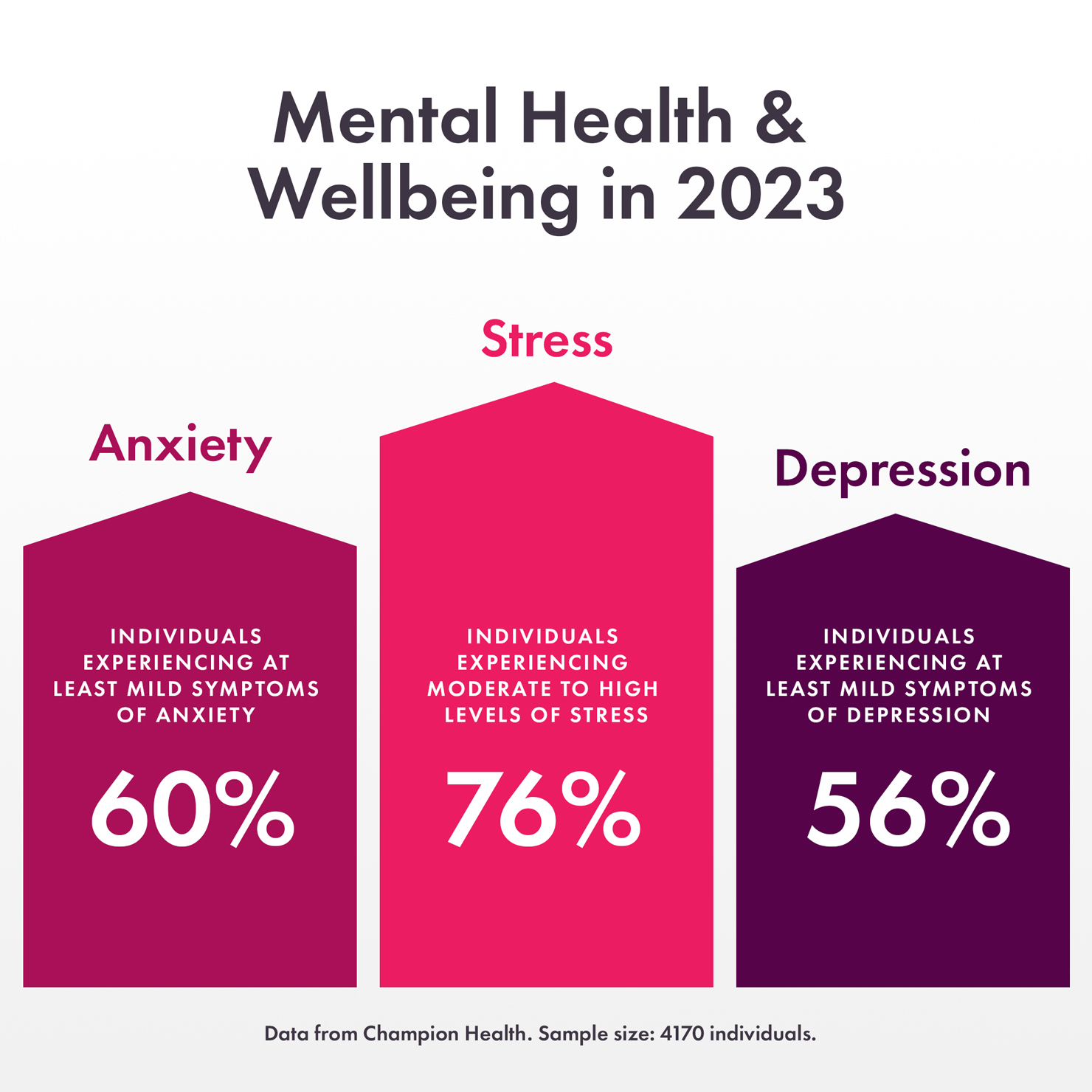Finding ways to help employees reduce workplace stress is a top priority for HR and wellbeing experts.
And with employee wellbeing statistics revealing that 60% of workers are experiencing moderate-to-high levels of stress, workplace stress is among the most significant challenges facing UK organisations.

But it’s a daunting challenge; there are many causes of work-related stress and together they can overwhelm your employees, leading to a drastic worsening of their mental and physical wellbeing.
That’s why it’s so important to do all you can to address sources of stress in the workplace, while also learning how we can support those affected.
Whilst stress is part of our evolutionary history and biological make-up, we can use factors within our control, as individuals and leaders, to reduce the effects of stress on ourselves and others.
In this guide, we’re going to run through some actionable ways to help employees manage stress – whether that’s educating yourself to spot the signs of stress or implementing new wellbeing initiatives.
You’ll discover:
- What is work-related stress?
- Why do organisations need to reduce workplace stress?
- Ways to help employees reduce workplace stress
- Learn to recognise the symptoms of stress
- Understand how to respond
- Support employees to develop stress coping skills
- Reduce the gaps
- Lead by example
- Be transparent
- Involve employees in the decision-making process
- Help your employees to be more social
- Create quiet time
- Develop a supportive workplace culture
- Offer training and development opportunities
- Reduce concern during periods of change
- Manage workload
- Improve work environments
1. What is workplace stress?
Work-related stress is a common response to pressures exceeding our ability to cope.
A certain amount of stress in work may be perceived as acceptable, or even healthy, by an individual.
However, when that pressure becomes unmanageable, it becomes an issue which can damage both an employee’s health and their performance (take a look at the image below for a visual illustration of this).
When this happens, support from a manager or colleague is crucial.
2. Why do organisations need to reduce workplace stress?
Protecting your employers from work-related stress makes sense from a moral, legal and financial standpoint.
First, there is the moral angle consider. Employee wellbeing should be a priority for every organisation and every employee should have an equal opportunity to succeed, regardless of their mental health.
Organisations also have a legal duty to respond to cases of work-related stress, as it is considered a disability if it has a long-term effect on the day-to-day activities of employees.
In these cases, organisations are legally required to provide reasonable adjustments to support those employees.
There is also the business angle to consider, with work-related stress causing the loss of over 15 million days of work, and costing UK organisations over £5 billion annually.
3. Ways to help employees reduce workplace stress
1. Learn to recognise the symptoms of stress
To really help your employees manage stress, you’ll need to learn how to recognise the symptoms.
We can split the symptoms of stress into four areas: physical, cognitive, behavioural and emotional.
Physical symptoms can include headaches, muscle tension, tiredness, chest pains and heart palpitations.
While cognitive symptoms include low concentration, irritability, fatigue and impaired memory.
Stress affects our emotional state too with symptoms including emotional outbursts, low mood, sensitivity to criticism, low confidence, anxiety and anger.
You may also notice the following:
- Disagreements and arguments
- Decreased performance
- Higher sickness absence
- Higher staff turnover
For a more in-depth look, read our guide on spotting mental health issues at work.
Now you can spot the signs, it’s time to understand how to respond.
2. Understand how to respond
Before we talk about organisation-wide initiatives to reduce stress, it’s important that you know how to support an employee on a personal level.
If you believe one of your employees is feeling stressed, it’s important to talk to them. Approach them, ask open questions about how they’re feeling, and show that you’re concerned for them. You may need to be direct and assertive to show your concerns, but it’s important not to be forceful.
When a colleague opens up to you, listen non-judgementally and avoid giving unsolicited advice. You don’t need to have all the answers, simply making it clear you care is a great place to start.
Once you’ve listened, reassure your colleague that you’re there to help and ask if there is anything else you could be doing to support them.
Aim to get regular touch points scheduled in – whether that’s a team meeting or 1:1, so you can continue to support them, and show your support is available going forward.
However, you are not expected to be an expert in mental health, and there may be times when the employee requires help beyond your capabilities.
When this happens, it’s helpful to know the relevant support you should signpost them to. This could be internal services, such as an EAP, or external services, such as Mind, Samaritans or Rethink Mental Illness.
3. Support employees to develop stress coping skills
When we feel like we don’t have the resources to cope with the demands placed upon us, we begin to feel stressed.
But what are your options to support your employees?
- Option 1: Take the demands away
- Option 2: Ensure your employees have the resources to manage the demands
It’s clearly not always possible in the workplace to choose option #1, but you can support your employees to build enough resources (the skills to cope) to effectively manage their demands. This will in turn enable them to better manage work-related stress.
This is the basis of the Job Demands-Resources theory. Helping your employees to maintain a balance between their resources and demands will support them to stay engaged, challenged and motivated despite the demands of their career.
For a practical exercise to complete with your employees, take a look at #2 on this post on health and wellbeing tips at work.
4. Reduce the gaps
Another strategy to help your employees manage stress is to coach them to choose a gap – e.g., something that is causing them stress – that they can do something about.
“Any gap will do to start with – it doesn’t have to be the biggest or most uncomfortable; working on reducing stress in this area, in any way, leaves us better able to deal with the rest.
Even if they can’t close the gap fully, reducing it little by little can still make it easier to cope with,” suggests Sue Evans, founder of workplace wellbeing consultancy FAST Pathways
5. Lead by example
Work-induced stress isn’t solely an employee’s problem to solve. In fact, managers and leaders play an important role in modelling healthy behaviours.
Change must start from the top and unless you’re leading by example, it’s unlikely your employees will engage. This can be true when it comes to helping your employees manage their stress.
If you are a leader, get vocal about stress reduction and educate yourself and the wider business about the symptoms and causes of stress.
This is about influencing the culture of your organisation, and that has to come from the top. So, even if you’re not a leader, you need to get them onboard. Where they lead, the organisation will follow.
6. Be transparent
To support your employees, it’s important that you’re honest and clear with them. This means acknowledge uncertainty – whether that’s caused by the pandemic or any difficult situation affecting that employee.
It’s also key to make your expectations clear. This could be that you expect your employees to set clear boundaries while they work from home, I.e. You only expect them to work within office hours. Something as simple as this can help your employees to avoid uncertainty which can lead to increased stress.
Finally, be transparent when it comes to their goals – make sure they’re clear and achievable. The SMART goals method will help you ensure a good level of transparency.
7. Involve employees in the decision-making process
Stress is strongly linked to the perception of control, so giving employees a say in how their work is organised and undertaken will give them a feeling of control that can act as a buffer against work-related stress.
Ways you could do this include:
- Allowing flexibility over working hours
- Working with the employee to set performance targets
- Giving employees some control over their pace of work
8. Help your employees to be more social
Whether working in an office, onsite, or from home, your employees spend a lot of time working together. And the more comfortable they are with each other, the less stress they will feel.
As co-workers get to know each other, expectations and communication barriers are broken down, making for easier interactions in the future.
One quick route for boosting social activity across your business – especially when working-from-home – is to create an online social channel using an online messaging platform like Microsoft Teams, Slack or WhatsApp.
Communicate that the channel is not for work and encourage your colleagues to engage without fear of being labelled as wasting time. It’s important that your people can socialise as much as possible, even if it is virtually.
9. Create quiet time
No matter how successful your wellbeing initiatives are, stress cannot be completely avoided. That said, you can help alleviate its effects by ensuring your employees have a peaceful space where they can take a break.
This could be as simple as an unused meeting room, office, or even an outdoor bench. The important part is to ensure that it’s separated from the daily grind, where your employees can take a few minutes out of the workday and not think about work.
Another strategy – particularly relevant to home workers – is to consider blocking off time during the working week.
This could mean implementing “No Meeting Mondays” or an hour of each day where meetings are discouraged, and employees are encouraged to focus on one individual task.
This can help employees to avoid getting bogged down in meetings or overwhelmed by a heavy workload, which can increase stress.
10. Develop a supportive workplace culture
Creating and sustaining a supportive workplace culture, where colleagues can openly talk about their struggles with stress or other aspects of mental health, is key to reducing stress within your workforce.
However, it can be challenging to develop this type of culture, especially in organisations that have not focused on wellbeing initiatives before.
Your first action will be simply to get the conversation started and start to break down the stigma that unfortunately still surrounds stress and mental health.
Many employees will be wary of discussing their mental health concerns and others may be worried about the impact opening up could have on their careers.
Try starting with something as simple as asking your colleagues how they’re doing on a regular basis – making it clear that you care is a great first step to developing a supportive workplace culture.
For additional tips on introducing wellbeing at work and ultimately reducing employee stress, we’ve put together a more detailed article.
11. Offer training and development opportunities
Job security and concerns around development can be a significant stressor for employees. You can reduce this by offering training and development opportunities.
Ask your people which skills they would like to develop and the direction they would like their career to take, then work together on the training you can offer that would be most beneficial to them.
As well as easing concerns around job security, offering this training will also increase their ability to perform well in their role.
12. Reduce concern during periods of change
Change is very common within a workplace, especially during the COVID-19 pandemic.
However, you should never underestimate the effects of these changes on your wellbeing and your employees’. Even seemingly small changes can significantly impact morale and level of work-related stress.
During periods of change periods, you need to ensure that your employees feel informed, trusted and motivated.
Be completely transparent with your employees about any changes that are taking place. Explain to them the reasons behind these changes and encourage them to ask for further clarification if necessary.
13. Manage workload
According to CIPD, workload is the most common cause of work-related stress. If work volume or deadlines are beyond the capabilities of your employee, then that is likely to become a major source of pressure.
It is your responsibility to ensure that your employees can cope with the demands of their job. You can do this by:
- Setting demands that are achievable within the hours that they work
- Ensuring that an employee’s skills and abilities are matched to the demands of their job
- Addressing any concerns an employee may have about their job demands
- Holding regular meetings, both with individuals and teams, to discuss upcoming workloads, and any predicted busy periods
- Notifying employees of any unplanned tight deadlines or any exceptional needs to work long hours
14. Improve work environments
Your employees (and you) can become stressed if the work environment is uncomfortable, influences unhealthy behaviours (like minimal movement), or contributes to health conditions, such as MSK pain.
If the working environment is causing the employee to experience work-related stress, then work together to discuss ways that you could change this. Changes could include:
- Allowing employees to work in a private space
- Giving employees the option to work from home
- Encouraging employees to regularly break their sitting periods (at least once every hour)
- Encouraging employees to take a 10-minute walk before starting work, or at lunch
- Ensuring employees have their workstation set-up correctly (start by ensuring their screen is at eye-level)
If you have budget available, it’s also well worth supporting your employees by investing in standing desks, quality office chairs and new equipment.
How employers can reduce stress in the workplace – Looking forward
Work-related stress is not a problem that simply resolves itself and it should not be accepted as a requirement of working life.
Your people will remember how you, as their employer, treat them in difficult moments. If an employee is experiencing work-related stress, take the opportunity to rise to the challenge, and demonstrate your commitment to their wellbeing.
By doing so, you can drive a culture of thriving and high performance throughout your organisation, where employees are able to perform at their best, while thriving inside and outside of the workplace.







